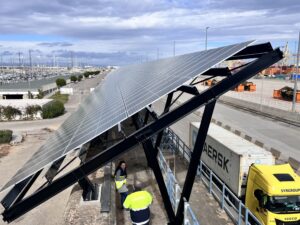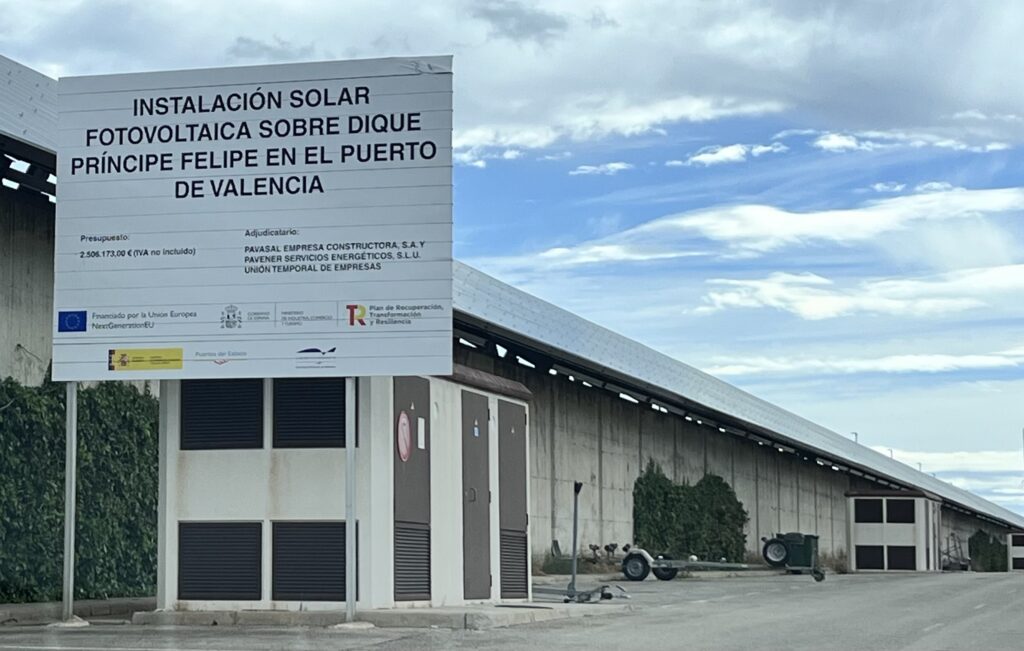
- The new infrastructure, which began operating in a trial period in December, will generate 2,297 MWh/year, that is to say, 3.5% of the electrical energy consumed by the Valencian docks. Meanwhile, the solar park being built on the VTE silo will generate 18.5% of the electricity consumed by the Valencian docks
- This project is part of the decarbonisation plan of the Port Authority of Valencia (PAV) which envisages an emission neutral port for the coming years
- The project has been subsidised by the Next Generation funds of the European Union and the Recovery, Transformation and Resilience Plan of the Spanish Government
València, 17 April 2024 – The Muelle Príncipe Felipe solar installation is now 100% operational. The infrastructure was connected to the electricity grid in a trial period in December and, since January 2024, it has been operating at full capacity, supplying an average of 3.5% of the energy consumed by the site.
The importance of this project is part of the decarbonisation plan of the Port Authority of València (PAV) which envisages an emission neutral port for the coming years. The start-up of this infrastructure is the first step towards converting the Port of Valencia into a 100% green enclosure. Specifically, this installation will generate 2,297 MWh/year and its first milestone was recorded on 1st January this year, the day on which it fed practically 100% of the energy required by the Port for its operation into the electricity grid.
In addition to the photovoltaic plant on the Club Náutico breakwater and on the Príncipe Felipe dock, another solar park will soon be added on the roof of the Valencia Terminal Europa vehicle warehouse. Between them, they will produce 22% of the electrical energy required by the site. Both projects are financed by the European Union’s Next Generation funds and the Spanish Government’s Recovery, Transformation and Resilience Plan.

This morning, Mar Chao, president of the Port Authority of València (PAV), visited the installation accompanied by Federico Torres, head of Energy Transition of the PAV. During the visit, other energy projects underway were discussed, such as the imminent start-up of the installation of another solar energy plant in shed 4 of the Port of Gandía which, once in operation, will make this area the first European port to be energetically self-sufficient. It was also announced that in parallel, new locations are being sought for other projects related to solar energy.
Chao thanked the installation itself for the work carried out by the technical team of the Port Authority of València and the companies awarded the contract which have made it possible “for such an important installation, which was once a project, to become a tangible reality that is helping us to achieve our objectives of decarbonisation”.
2,290 photovoltaic modules
Torres explained the technical characteristics of the installation and the performance targets that are expected with its commissioning, “it has an installed power of 1,039 kWp and will generate 2,297 MWh/year, that is, 3.5% of the electrical energy consumed by the Valencian docks”, he pointed out.
In total, the installation is made up of 2,290 photovoltaic modules that occupy a surface area of 6,420 square metres distributed over 850 linear metres of structure, “the panels have a 30% slope to make the best use of the sun,” Torres explained during the visit.
Decarbonisation as a goal In addition to the solar projects, there are other initiatives related to the use of renewable energy sources such as wind, solar, biomass, biogas, wave and tidal energy and hydrogen. Likewise, the plan developed by the PAV to become a 100% green port also contemplates the development of other transversal plans such as, for example, the extension of the railway connections, the construction of two electrical substations to enable the engines of the ships docking at the Valencian precinct to be connected to the electrical network or the use of hydrogen in port activity. This decarbonisation plan will contribute to the strategic objective of being an emission neutral port in the coming years.

